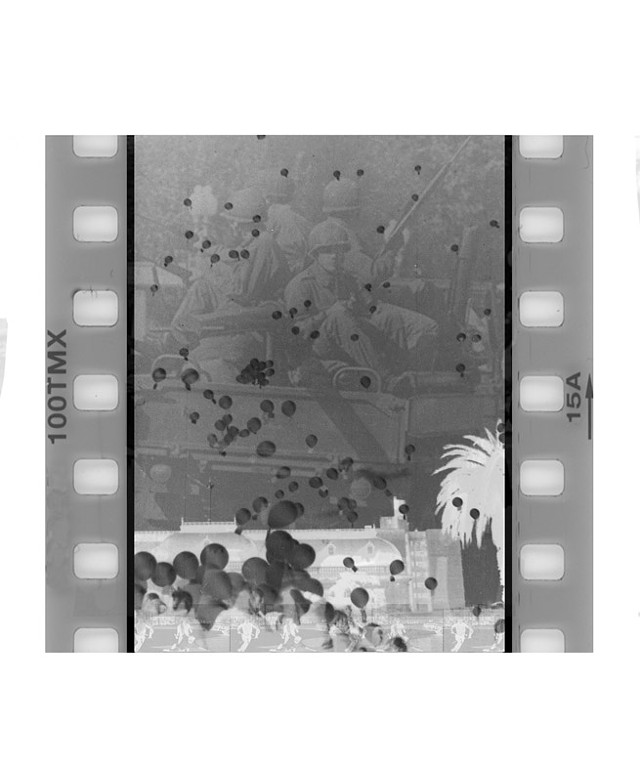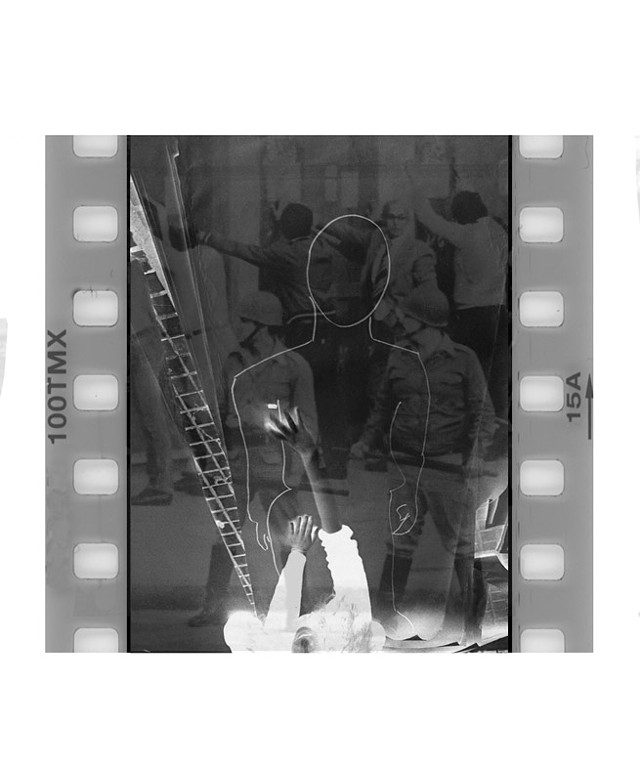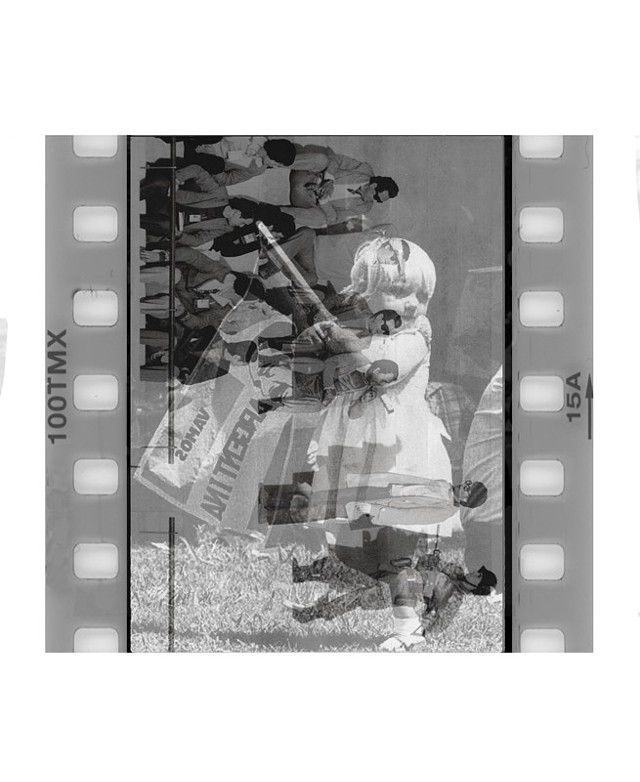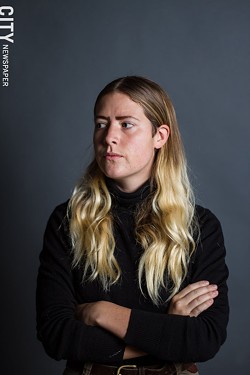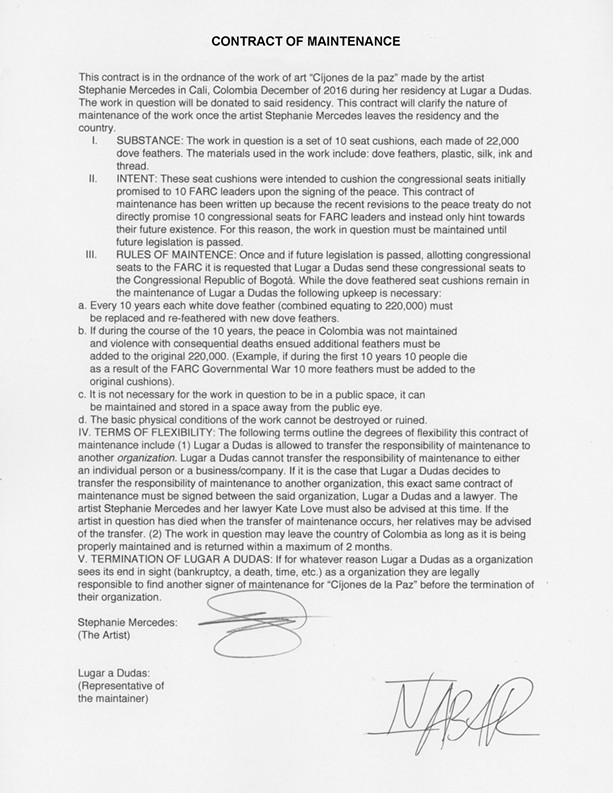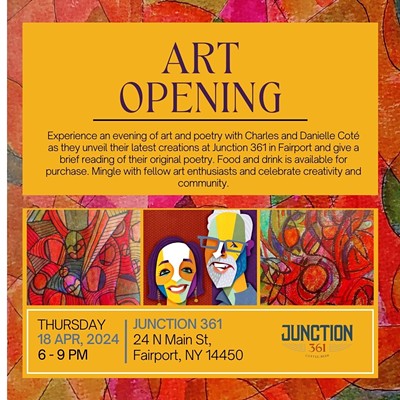
[
{
"name": "500x250 Ad",
"insertPoint": "5",
"component": "15667920",
"parentWrapperClass": "",
"requiredCountToDisplay": "1"
}
]
When we think of individual artists, most come with the association of a specific chosen medium. A smaller number of creatives, like Argentinian-American Stephanie Mercedes, float from one material to the next, each new body of work determined by the message they want to get across. Mercedes's work includes a unique aspect: she folds law and dissent into her artistic practice.
Mercedes is in Rochester through the end of April as an artist-in-residence at Flower City Arts Center (formerly the Genesee Center for the Arts and Education). She is working on the second phase of her current photography project, "Luz del Día: Copyrighting the Light of Day." Through a creative use of copyright law, Mercedes seeks to pierce the veils that shroud Argentina's Dirty War and build an archive of photographic materials to protect the memory of the disappeared. Her Rochester residency will culminate in a public exhibit of her project-in-progress as well as some workshops focusing on art and dissent.
When the project is completed, Mercedes will have re-photographed 3,338 images — one for each day of the Dirty War — and altered them according to copyright law in order to create her own archive, which she will make available to the public through Argentina's General Archive of the Nation.
Mercedes is equal parts detective, researcher, artist, activist, documentarian, and educator. She graduated from Smith College with a degree in Latin American politics and studio art, and has performed and exhibited in Argentina, Brazil, Mexico, Switzerland, and the US. And she is currently exhibiting her first solo show in the US; the show opened last month at New Orleans's Common Ground Gallery.
"In the same way some artists pick up photography, performance, or sculpture, I'm picking up law as form, and intervening in systems of power," Mercedes says. "My mother is a lawyer. Law has kind of been a part of my work all along, because it was a part of me growing up. I thought about going into law before I thought about going into art."
The Flower City Arts Center's residency program in photography launched last summer, and Mercedes applied, voicing a specific interest in the darkroom facilities — even though she's not a photographer.
"But the project is photo-based," says Megan Charland, the center's photography program manager. "Her proposal was specifically to turn photographic images into negatives, so that legally she has the right to them."
Before Mercedes began work on her photography project, she was a fellow at Art + Law, a Brooklyn-based artist residency. While she was studying intellectual property rights and copyright rules, a friend in Argentina emailed to tell her that a bill had been proposed to extend coverage under Argentina's copyright laws from 20 years post-production to 70 years after the photographer's death. United States copyright law states that a photographer owns their images throughout their life and 25 years after death.
During Argentina's Dirty War (1974 to 1983), the military dictatorship tortured and killed or "disappeared" between 10,000 and 30,000 people it believed posed an ideological threat to its rule. These perceived subversives included intellectuals, photographers, students, and artists.
"If you have a dictatorship and you have people who are against the militia, the first people you go after are artists, photographers, and people who work for the newspapers," Mercedes says. "So a lot of the visual representations of that period of time were taken by people who were 'disappeared.'"
Because there are no records of the deaths of many of the victims — there's no physical corpses — they're not technically considered deceased. So if this bill passes into law, all photographs documenting this period which currently exist in the public realm would become privatized by the state. In addition, images by photographers whose deaths were never established would be removed from public access indefinitely. Any currently-public images would be removed from Wikipedia, social media, and news sources that do not own them.
Mercedes drew her project's title from documentation released last year of correspondence between then US Secretary of State Henry Kissinger and Argentina's dictator General Jorge Videla. In the correspondence, Videla attempts to remember the number of people killed during a five year period. At the end of the correspondence, he notes the numbers are unimportant as they "will never see the light of day."
"A photograph is really just about a relationship of light," Mercedes says. "And a documentary photograph can be about a pornography of violence, almost something that is undepictable. For me, this period of Argentinian history is completely undepictable. It's not something I could ever imagine, reimagine, or fathom. I felt like the process of light was important, because people's relationship to the archive is a physical thing, it's not about a realistic photograph, but having a relationship to something that existed from those people who died."
She says her project isn't about preserving the image; it's about preserving the archive. So the images can be an abstraction that still depict figures, but are more about the dark and the light.
The dictatorship in Argentina, Mercedes says, is a period of time that no one really talks about. "You don't study it in school, you don't talk about it with your parents or your grandparents. Argentina is still trying to reconcile with what happened. And it's a hard thing for a government to try to reconcile with something that happened so recently."
Because nothing is known about what happened to many of the disappeared, there's a desire to connect with that, which is not easy, she says. "That's why the archives are so important, and to have them be inaccessible to the public is completely unimaginable."
Luz Del Dia: Copyrighting the Light of Day by Stephanie Mercedes from CITY Newspaper on Vimeo.
Mercedes originally planned to source most of the material for her project from the National Archive in Buenos Aires. She got permission to visit in December 2016, with the understanding that there would be a small fee for taking away digital copies of the images she wanted.
But to her astonishment, the archive, which was established in 1821, conveniently ended in 1976 — the year the Videla dictatorship began — though there was an entire section dedicated to recent president Cristina Fernandez de Kirchner.
Laura Tusi, an Argentinian art and law specialist, was also conducting research that same day, Mercedes says. Tusi helped Mercedes find the few photographs from this era that did exist in the archives. They depicted innocuous activity seemingly unrelated to the political turmoil.
Tusi explained the importance of Fotos Huérfanas (Orphaned Photographs), images whose rights holders are indeterminate or uncontactable (such as someone who has disappeared) and are unlikely to be available in public archives. Tusi connected Mercedes with other experts and archivists of Fotos Huérfanas from 1976 to 1983.
Mercedes also worked with some private photographers who have maintained their own archive. In particular, photojournalist Mónica Hasenberg has been important to Mercedes's project: Hasenberg has more than 45,000 negatives of her own images from when she worked for periodicals during the Dirty War.
Hasenberg and her husband, Brenno Quaretti — a documentary photographer who died in 1995 — were two of the most important photographers during the Dirty War. Their archive, "Hasenberg-Quaretti," is one of the largest collections of 1980's Buenos Aires.
Hasenberg says that during the Dirty War, she and Quaretti were as vulnerable to the dictatorship's actions as any other photographer, but they hid their negatives away and only began making prints after the danger had passed. She has given Mercedes full access to her archive, and referred her to some alternative sites that photographers, artists, and intellectuals have been using as a collective open source archive, which Mercedes says will be an invaluable resource for "Luz del Día."
"Some of the photographs are really violent, of people being dragged off," Mercedes says. There are also photographs of street protests, including images of the Asociación Abuelas de Plaza de Mayo (Grandmothers of the Plaza de Mayo) protesting with Argentinian Modernist paintings. "I really love the idea of these mothers, who then turned into grandmothers, protesting with large canvases," she adds.
Mercedes is interested in the relationship viewers can have to the moment when a photo was taken, not just the depictions of horrific violence. In the interest of giving some context of everyday life during the dictatorship, some images are banal, or are photographs of empty cells. They range from absurdity and violence to mundane daily life, she says.
Another important resource for Mercedes has been the Escuela Superior de Mecánica de la Armada (the "Higher School of Mechanics of the Navy." ESMA was originally an educational facility for the Argentine Navy. It was used as an illegal secret detention center during Argentina's military dictatorship where thousands were tortured and executed. Babies born to mothers imprisoned there were given new identities and illegally adopted by military families.
ESMA is now home to one of the largest national archives from the Dirty War, "El Archivo de la Memoría." All of its images are open to the public except those that are orphaned. "Those are the photographs that I want, because they were probably taken by los desaparecidos," Mercedes says.
Where photography is concerned, copyright law usually benefits the maker of the images, protecting against the use of their work by others. But Mercedes is using the law to her advantage.
"In a way the project is taking the idea of copyright and inversing it," Mercedes says. "By privatizing the archive, and by copyrighting it, I'll actually be able to make it accessible to everyone." This is an important measure regardless of whether the bill is passed, because even if the images remain in the public domain, they are in the hands of the government or whoever is in power at the time.
Mercedes has to make four alterations to the images for them to be considered legally her own. These adjustments include transforming the digital images into film negatives, cropping the images, changing the light balance, and layering the images.
She's in the process of re-photographing the physical images she acquired in Argentina, processing them into film and printing new negatives — she will display those negatives on lightboxes at the center for her exhibition showing the project's progress this month. Some of the negatives will be enlarged and printed onto transparency paper and also displayed on lightboxes.
"I like this idea, because it makes each image more of an object than an image, and makes it more about its relationship to light," she says.
Whenever information about when the images were taken is available, Mercedes will match her re-photographs to a date in the timeline of her 3,338 image archive.
This isn't the first time Mercedes has utilized law as form in her work; in the past it's manifested as a slick use of contracts. While it's not uncommon for artists to sign contracts with the people or organizations that commission their work, Mercedes uses them in a distinctive way.
In October 2016, Mercedes did a month-long project in the rural, highly conservative Nebraska City (its tourism site's tagline is "Red to the Core"). She recorded people in the small town holding their breath, and made a vinyl record of the recording.
"I wrote a contract with the local law library that said they have to play the record nonstop," she says. "If the law library burns down, or something happens to them, they have to find someone else to take and play the recording. It's creating a perpetual pause, which kind of felt like the town that I was in."
Another recent contract resulted from a residency at Lugar a Dudas in Cali, Colombia, where she created a project related to the peace treaty agreement between the Colombian government and FARC rebels.
"In about five or 10 years' time, they will allow 10 additional seats to be added to the Congress for the FARC members, which is insane," Mercedes says.
During the 52-year war, 220,000 people died. So Mercedes used 220,000 feathers from doves — which are symbolic of peace — to create seat cushions for the new congressional members. She wrote a contract of maintenance with the gallery: when the FARC seats are allocated, they will send the cushions to Congress, and every five years, they have to re-feather the cushions. "And if more people die, they have to include more feathers," she says.
Mercedes's inspiration came from a phrase repeated in Colombia — "the government officials were using FARC rhetoric to feather their cushions."
She also created two small sculptures of bullet-sized dove ornaments, one made out of cocaine and the other out of soap. "The war was funded by the cocaine industry," she says. "So one dove is attempting to cleanse and move forward, while the other is made from what the 'peace' was made of."
In the autumn of 2015, Mercedes attempted to deliver 1,000 yellow dahlias — Mexico's national flower — to Donald Trump at Trump Tower. Each flower came with a handwritten message from Latino New Yorkers to the then-candidate in response to his xenophobic rhetoric. Mercedes worked with the Brooklyn branch of the Latino not-for-profit organization Make the Road to collect the notes.
"It's important to me not to speak for other people," Mercedes says. "Rather than offering a solution, I want to create spaces or gestures in which everyone's voices can be heard."
In 2016, Mercedes installed a sound sculpture, "The Ring of Freedom," at El Teatro Municipal, San Isidro, while she was in Buenos Aires conducting research for her current project. The work was commissioned by Art in Odd Places in Orlando.
The sculpture consists of a mobile of 49 individual liberty bells — one for each of the victims of the Pulse nightclub shooting — created by melting down and re-casting the metal from a Sig Sauer rifle, which is the gun used in the shooting.
Mercedes made a second set of bells, which she distributed for free during Pride Weekend in Orlando at a "liberty booth." A liberty booth is a means of recruitment for the NRA's Women's League, The Ring of Freedom. Mercedes says she noted that most of those bells made their way to the victims' memorial by the next day.
She says ultimately she'd like to have the gallery set installed in the NRA's garden, and she's been in correspondence with them to this end.
By and large, Mercedes has been successful at acquiring cooperation for her politically-charged projects from different groups of people and institutions, even in cases when they might not like the points she is trying to make through her art. This has great potential to open up discussion and collaboration between people on opposite sides of the fence. She calls this phenomenon "reversion from within." But it doesn't always run smoothly.
For example, Mercedes says the gallery she worked with for her congressional seat cushions in Colombia, Lugar de Dudas, signed her contract, but the manager was less than thrilled when he realized what he signed.
After President Obama re-opened the US trade relationship with Cuba, Mercedes created an ad to go on the side of a bus in Massachusetts that was simply a picture of the open sky. The contract she wrote was that the ad would run indefinitely. "The idea is that it's a perpetual false open sky," she says. "So if they go out of business, they are legally responsible to make sure the ad goes onto another form of public transportation."
"I think they just thought, 'Oh, it's an artist,' and signed the contract," she adds.
Mercedes attributes the success of some past projects to her method of approach. For example, in contacting the NRA, she pretends to support the institution. They understand it's an art project, and institutions like working with something as solid as a contract. "But until I get a contract signed, and the work is installed legally in their garden, I have to be careful about the way that I approach them."
Part of her success might be written off to the fact that groups and organizations aren't familiar with her work as a political artist, and didn't see her coming until her carefully-crafted contracts were signed. It remains to be seen if Mercedes will have more trouble — and if groups will conduct a more close reading of the contracts — when her work is more widely known.
Speaking of...
Latest in Art
More by Rebecca Rafferty
-

Beyond folklore
Apr 4, 2024 -

Partnership perks: Public Provisions @ Flour City Bread
Feb 24, 2024 -

Raison d’Art
Feb 19, 2024 - More »

